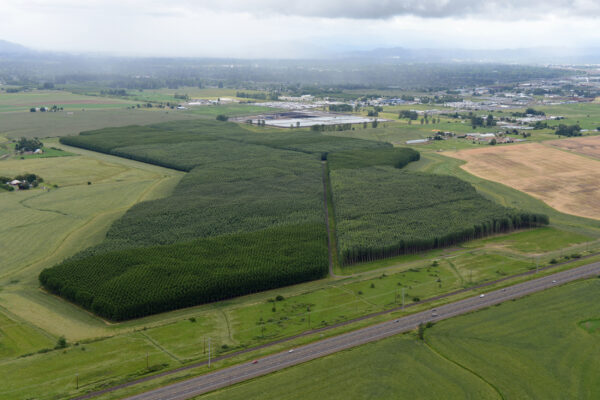Biocycle Farm Poplar Harvest Frequently Asked Questions

What is the Biocycle Farm?
The Biocycle Farm is a 600-acre parcel of farmland owned by the Metropolitan Wastewater Management Commission (MWMC). 400 acres are planted with hybrid poplar trees and serve as an agricultural fertilizer application for the MWMC’s Biocycle – the nutrient-rich biosolids processed from organic materials pulled from the wastewater treatment plant. The remaining 200 acres are used as hayfields and pasture for sheep.
Who operates the Farm?
The City of Eugene operates the Farm for the MWMC. The City of Springfield partners with the City of Eugene to develop management plans for the Farm.
What is the purpose of the Farm?
The purpose of the Biocycle Farm is to ensure the MWMC meets its goal of recycling 100% of biosolids for beneficial uses. The dedicated farm site provides a high degree of flexibility in fertilizer application and complements other local farm application sites. The Biocycle Farm helps the MWMC deliver safe and environmentally-beneficial products, with the added advantage of producing revenue to offset its operating costs. These benefits were all objectives of a citizens advisory committee that informed the MWMC’s decision to establish the Biocycle Farm.
What does the Farm produce?
The Biocycle Farm produces hybrid poplar wood products used for building materials, paper products, fuel and energy production, soil amendments and other applications.
Is the MWMC planning to plant more acres of poplar?
Currently the MWMC has no immediate plans to increase the number of acres grown in poplar. However, the Biocycle Farm and adjacent MWMC facilities offer the MWMC the flexibility to expand poplar acreage should it prove beneficial to do so in the future.
How does the Biocycle Farm protect the environment?
Rapidly-growing hybrid poplar trees are planted specifically because they absorb more nutrients per acre than most other crops, protecting groundwater from nitrates that leach from other agricultural sites. Poplar’s dense root networks excel at breaking down pollutants. In fact, hybrid poplars are used to clean up contaminated sites at locations around the globe. These attributes are important as the Biocycle Farm is located in a seasonal wetland environment, providing valuable ecological services throughout the year – protection of soil health and groundwater in the summer, and wetland filtration and groundwater recharge in the winter.
Do the trees remove carbon from the atmosphere?
Yes! While the Biocycle Farm is not intended as a carbon sequestration site, the rapidly growing trees incorporate a lot of carbon as they grow. Scientific estimates indicate that after five years of growth, these poplar trees can remove over 3 tons of carbon (measured as carbon-dioxide equivalents or CO2e) per acre per year. The Biocycle Farm may hold 18,000 tons CO2e or more in its trees in a given year. If harvested poplar is turned into products like building materials or biochar (a soil amendment charcoal product) that do not release the carbon back into the atmosphere, this stored carbon could increase the overall sequestration value of the Biocycle Farm.
Are there any local economic opportunities associated with the Biocycle Farm?
The Biocycle Farm has produced jobs and farming opportunities since it was started; as the Farm continues its operations and produces more products for market, additional opportunities in the milling, lumber, and building industries will increase. Besides contract crews needed to plant, prune, and harvest the trees, local farmers use the Biocycle Farm to graze sheep or maintain hayfields in unplanted areas. Local industries have used Biocycle Farm poplar to produce energy, charcoal, plywood products, and ceiling panels.
Why poplar trees?
Poplar trees were chosen for the Biocycle Farm because they grow rapidly and consume large amounts of water and nutrients from either “liquid biosolids” (water mixed with processed biosolids) or dry biosolids and recycled water. Poplars absorb at least twice the amount of nutrients as rye grass per acre, which makes them a preferable crop for maximizing the amount of biosolids that can be applied to a field. This asset is not shared by crops like Christmas trees or mint. Additionally, poplar trees reach harvest maturity within 12 years, which makes them an agricultural crop. Forestry is not permitted on the Biocycle Farm’s agricultural lands.
What is hybrid poplar?
Poplar is a genus of tree in the willow family that includes aspen, cottonwood, and poplar. Hybrid poplar varieties are crosses of two different species to produce clones having desired characteristics – such as weather hardiness and straight trunk growth. The trees on the Biocycle Farm include hybrids of native cottonwood species as well as Eastern, European, and Asian poplars.
Is hybrid poplar genetically modified (GMO)?
No. The trees chosen for Biocycle Farm are not genetically engineered in any way. Unlike genetically-modified organisms (GMO) in which the genetic code is manipulated in a lab, hybrids are merely the result of age-old cross-fertilization. Hybrid reproduction is achieved through vegetative propagation (i.e., cuttings) in much the same way that roses, grapes, and similar plants are cultivated. Trees generated from cuttings are referred to as “clones” because they carry the same genetic attributes as the original parent plant.
What is harvested poplar used for?
Hybrid poplar have traditionally been grown by paper companies for pulp, as poplar has an strong, light-colored fiber ideal for paper and cardboard products. These same properties make poplar a good resource for plywood veneer, furniture frames, shipping boxes and molding and trim work. Poplar fiber is also an ideal raw material for biochemicals and biofuels as an alternative to petroleum products – in fact, passenger jets have been successfully tested to run on poplar biofuel.
Why does the MWMC grow poplar instead of a commodity crop like Christmas trees or hemp?
The MWMC’s Biocycle Farm is first and foremost an integral part of our regional wastewater management strategy. Poplar trees provide the nutrient uptake and other beneficial uses for biosolids. Furthermore, the poplars are well-suited to environmental conditions such as seasonal wetland flooding, which would not be conducive for other trees or crops.
Is poplar a useful wood like Douglas-fir?
Hybrid poplar is a softer, more rapidly-growing tree than Douglas-fir. Currently, local timber markets are primarily geared for manufacturing products from plentiful local Douglas-fir and similar conifer species, such as structural lumber. Poplar has its own unique characteristics that make it ideal for lightweight building materials, trim work and frames, and paper and fiber products. The MWMC is working with the wood products industry to achieve local market opportunities for poplar.
I see poplar boards at local supply stores – is that a market for Biocycle poplar?
Wood labeled “poplar” found in home improvement centers is typically not hybrid poplar, but is usually a tree called yellow-poplar (or tulip-poplar) harvested from eastern forests. Yellow-poplar is actually not a true poplar (similar to how Douglas-fir is not technically a fir tree).
Non-traditional uses of hybrid poplar are emerging, such as use in architectural ceiling panels and cross-laminated timber. Hybrid poplar is excellent for trims, non-structural boards, and similar uses due to its easily-stained light color and light weight.
Do the trees accumulate pollutants, like heavy metals, that impact its use?
Although the phytoremediation (pollutant reduction by plants) benefits of poplar is touted for cleaning up contaminated sites, the wood from Biocycle Farm poplar would not be impacted in any way. For one, biosolids contain only trace amounts of chemicals in very low concentrations, and secondly, the phytoremediation benefits largely occur in the root zone through bacterial action (as opposed to plant uptake and absorption).
How fast do the trees grow?
Under optimal conditions, poplars can grow as much as 8 feet per year, reaching heights of more than 70 feet and greater than 6 inches in diameter in 7- 10 years. Trees are harvested after 12 years. Many of the Biocycle Farm’s trees are 10-12 inches in diameter at harvest.
Why not grow the trees bigger – longer than 12 years?
The Biocycle Farm is an agricultural site, not a forestry site; therefore, poplar growth is limited by Oregon statute. After 12 years, the trees have reached 10- to 12-inch diameters and the growth rate slows down. While larger trees could be grown under forestry conditions, the optimal operational benefits of the poplar occur during years 4 to 12.
How much poplar is produced per harvest?
The MWMC expects poplar yields of approximately 50 bone-dry tons (BDT) of pulpwood per acre. This is based on optimally growing trees planted at a density of 222 trees per acre and harvested at Year 12. The suitable saw log material at harvest is expected to be approximately 30 to 33 thousand board-feet (MBF) per acre. The remaining pulp material yields approximately 17 to 20 BDT of chips. Additional material can be processed into hog fuel and used for mulch, compost, and bioenergy production.
How often are the trees harvested?
The Biocycle Farm is divided into three separate management units which are planted at different times. The MWMC harvests trees on a 12-year rotation (sometimes earlier depending on conditions). The MWMC’s initial rotation schedule results in a harvest once every 4 years, on average. The MWMC may opt to increase its rotation units from three to six (by dividing 100+ acre units into 50+ acre units), thereby increasing the average harvesting frequency to 2 years.
How are the trees irrigated and fertilized?
The poplars are watered and fertilized with 100% reclaimed wastewater resources: recycled water and biosolids. Both resources are applied to the soil via spray carts and automated hose reels attached to the Biocycle Farm’s underground irrigation loop. Biosolids are also applied in dried form via manure spreaders. In fact, dried biosolids production and application has been the more common practice in recent years.
Are pesticides used at the Biocycle Farm and on the trees?
The MWMC follows integrated pest management (IPM) practices which includes use of chemical herbicides. Herbicides are used to ensure that young trees are not overgrown by blackberries and weeds. Weed control is also performed through other methods, including grazing sheep and manual labor. Any chemicals used on site are reviewed and approved for ecological safety and may only be applied under the correct environmental conditions. Other pesticides may be considered for controlling voles or occasional fungal or beetle infestations on the trees. The MWMC strives to limit chemical uses under the City of Eugene’s environmental management system (EMS) practices. An exciting opportunity for poplar is production of natural chemicals and biofuels, such as acetic acid. Acetic acid is an effective weed killer, and one day the Biocycle Farm could be the source of its own herbicide.
Does MWMC prune the trees to make knot-free wood?
Young trees are pruned annually to promote good growth patterns and to allow farm equipment to access the tree rows without damaging the trees. Currently, pruning typically stops after the trees are 3 or 4 years old and no longer producing low branches. The wood produced to date from harvested trees shows good grain characteristics and aesthetics but is not knot-free. The trees could be pruned higher if market demand for knot-free wood warranted the cost of doing so.
Can the trees be coppiced (i.e., growing out new stems from stumps after harvest)?
While other poplar tree farms practice coppicing. The MWMC has so far determined that the practice is not suitable for the Biocycle Farm because coppiced trees: (1) Exhibit bushy growth that interferes with irrigation and biosolids application, (2) Need to be heavily pruned to a single trunk to produce straight, larger trees for harvest, and (3) Do not produce as high a value product for market as standard growth trees. However, some coppicing may be useful in the future for growing out stems for replanting. In this way, the Biocycle Farm could also be its own tree nursery.
What do you do with the stumps?
Because the Biocycle Farm does not coppice out the cut tree stumps, all stumps need either to be treated with herbicide to prevent grow-back, removed, or destroyed in place. Each method has different benefits. While stump and root wad material could be used as a source for charcoal, energy, or compost, the cost of removal is likely to exceed the value of these uses.
Where do the trees come from?
Hybrid poplars are sourced from various nurseries that grow out varietals for replanting. Planting stock comes in the form of stem cuttings typically ranging from 8 to 24 inches in length, or as whips measuring several feet in length. Cuttings are collected during winter dormancy and planted in the ground during the growing season. Cuttings can also be collected from new growth from other trees on the Biocycle Farm.
Can the trees be harvested in winter?
The Biocycle Farm needs to be harvested during the dry season due to the wetland conditions at the site throughout the rainy season. The preferred window for harvesting is as soon as the soil dries up in late spring through the end of summer. Land preparation for the next planting needs to be completed by early fall.
Who are your current partners and how do you work with local governments?
As a collaboration of the City of Eugene, the City of Springfield, and Lane County, the MWMC does not have any other formal partnerships related to Biocycle Farm operations to date. The MWMC has partnered with several organizations to promote education and research opportunities. Partner organizations have included OSU Extension – Forestry, Advanced Hardwood Biofuels, and the Northwest Youth Corps.
What are the opportunities for partnering with the Biocycle Farm?
The MWMC welcomes partnering opportunities, especially those that can help further the beneficial uses of poplar in local communities. Examples for partnering include research on soil productivity and health, growing and management efficiencies, production of biochar, acetic acid, biofuels or byproduct use, production and marketing of poplar millwork or building materials, or other opportunities that local partners may identify.
How might hybrid poplar from the Biocycle Farm benefit my business?
Many community members get excited about the sustainability loop demonstrated by the MWMC’s Biocycle Farm: the waste-to-commodity, sustainable wood product story is particularly appealing. The right business could align with those values to provide niche services essential to realizing enhanced and widespread uses of Biocycle Farm poplar in the community.
Does the Biocycle Farm support academic research projects?
Yes! The MWMC has partnered with OSU researchers on projects ranging from air quality to soil chemistry. The MWMC also participated in the Advanced Hardwood Biofuels research, which identified the opportunities for poplar’s environmental benefits, market uses, and eventual feedstock for biofuels.
I am interested in starting a similar project in my region, can you offer any advice?
The MWMC welcomes requests for tours of its facilities and is pleased to share knowledge and experience with others with similar interests. Please contact the MWMC to learn more.
Questions?
Contact the MWMC at mwmcpartners@springfield-or.gov or go to mwmcpartners.org for more information.
Have additional questions or interested in discussing a potential partnership? Reach out to us below!

